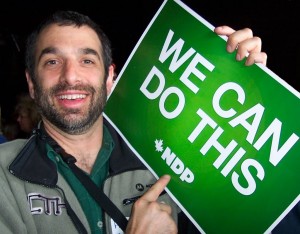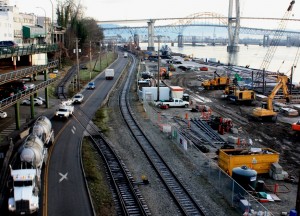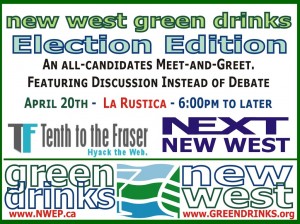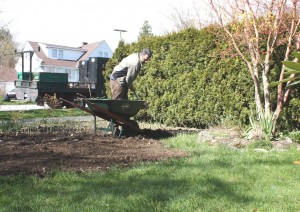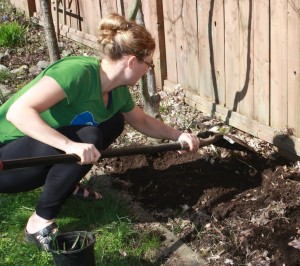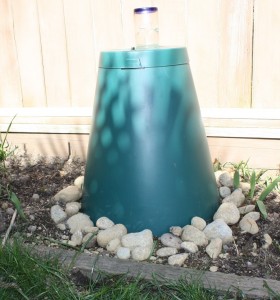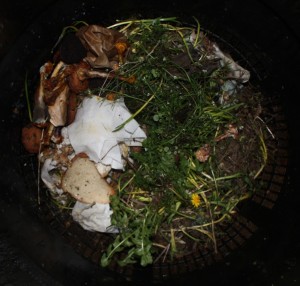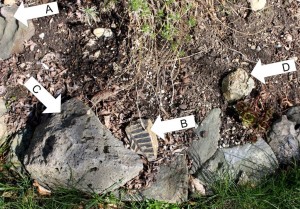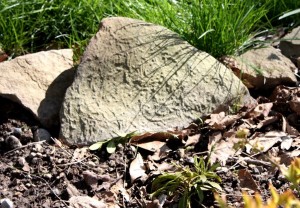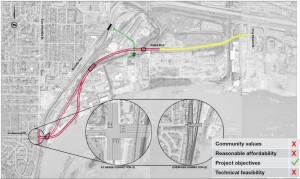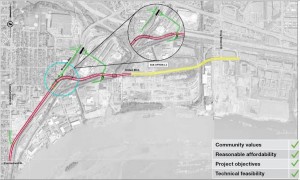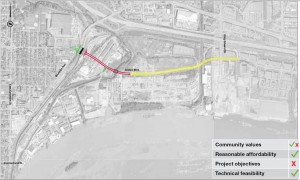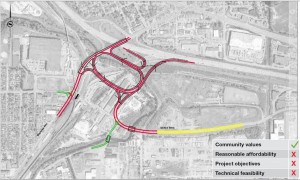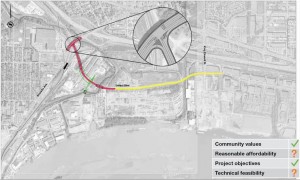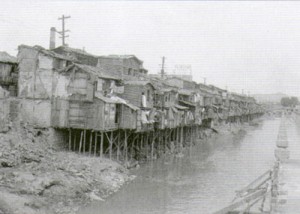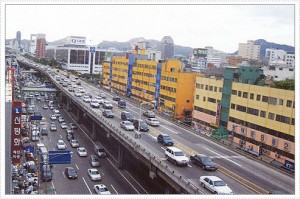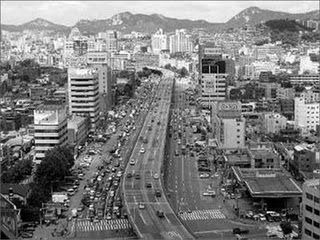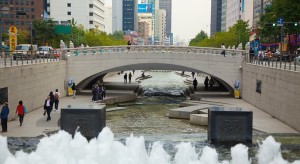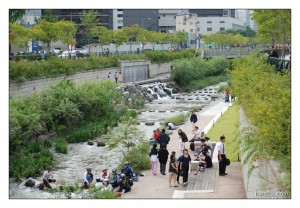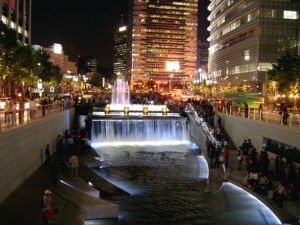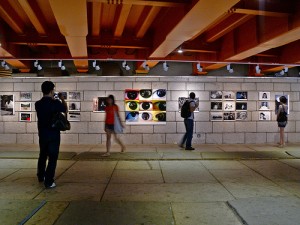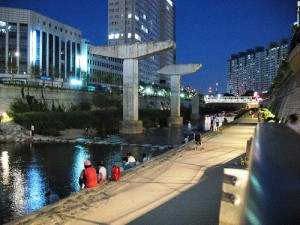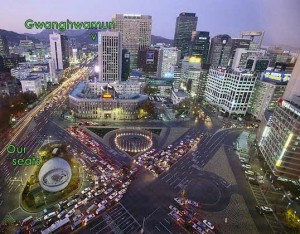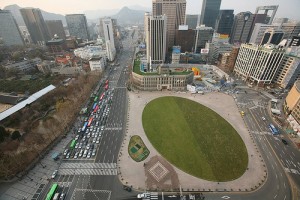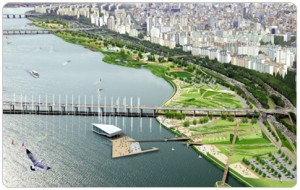There is an ongoing dialogue about the Pier Park going on in the comments section of the News Leader. I have hit this topic several times, have blogged about this topic before, and have actually met Chris Bell to discuss his concerns. But since I opened my fat gob once again to comment online on some comments I see as scare-mongering in Mr. Bell’s letter to the leader, I am now stuck here, blogging on what I see as a non-topic again, just to correct some facts on what I said, and in what Mr. Bell read into it.
The standard caveat: this project is close enough to my professional area that I should probably start by making some sort of declaration of my lack of knowledge. I cannot give a “Professional Opinion” on this topic, mostly because I am not privy to all the information. Everything I know about this project is from the public reports released through City Council and the media. So although I have significant training and experience managing contaminated sites across BC, and a pretty solid understanding of the Contaminated Sites Regulation and the Environmental Management Act, what follows is a personal opinion worth exactly what you paid for it: nothing.
I will go through Mr. Bell’s last comment to me, topic by topic.
“Patrick, you argue that the city showed due diligence before they purchased the pier land.”
The term “due diligence” does not mean you do everything humanly possible to find all available information about a piece of land. The “Due” part means that you do everything that should be reasonably expected to be done, that the effort and resources used coincide with what would typically be done in the industry.
When taking milk out of the fridge, good “due diligence” before handing it to your child to drink would be to check the expiry date, or maybe sniff the open bottle to see if it is rank, and to inspect for signs of curdle as you pour it in the glass. Running a mass spectroscopy analysis or doing an LD50 test on rabbits would probably provide ever further reassurance that the milk was not rotten or tainted with botulism, and is safe to drink, but that would be costly and time consuming, and would exceed “due diligence”.
In a real estate purchase, what is too costly or too time consuming? There is no upper limit to the amount of time and money you could spend investigating a site. You can drill holes and install monitoring wells across every meter of the ground, and still miss a 90cm-across block of uranium. A good rule of thumb for costing out these exercises is that every single monitoring well you install, including drilling costs, sampling, analytical costs for soil and groundwater samples, and all the accessory costs of doing the investigation, costs $5,000. Sometimes you can drill 10 for $30,000, sometimes only 5 cost you $50,000. But $5,000 per hole is a good order-of magnitude back-of-the-envelope guess for investigation costs. So what constitutes “due diligence” at $5,000 a hole?
In reality, we don’t in the industry machine-gun a site with $5000 holes, as potentially profitable as that would be for consultants. Instead, we look at the site history and make some educated guesses about the likelihood of contamination in certain areas, and dedicate our resources to those areas. Prior to the purchase in 2009, the City’s consultant took existing reports on the site (back to 2005), and used those as a basis for further investigation. This launched what is called a Supplementary Phase 2 investigation. They probably could have relied on those existing reports, but instead, they did a little extra diligence and went back to the previously identified “hot spots” and installed more monitoring wells. This, in my personal opinion, represents a level of due diligence consummate with the purchase of former industrial land that would become a park. I might have saved some money and dug some test pits instead of so much drilling, and relied on the existing wells more, but I’m a cheap bastard. I work for government.
Again, in my personal opinion as a taxpayer in New Westminster, this report demonstrates due diligence was performed on the environmental risk prior to the purchase. The City knew, as best as they could with reasonable efforts, what was there, and could make an informed decision about the purchase. You can disagree about the decision they made, that is your right as a voter, but you cannot say they did not exercise due diligence.
“The City has stated that the land purchase cost was reduced by the expected costs of remediation ”about 1.5 million dollars” and yet they ignored their own experts observations that vapour and off-site investigation of the lands to the north of the park must occur before the investigations could be considered complete.”
Let’s look at what the Supplemental Phase 2 report said. They confirmed the soil metals contamination previously identified on site, and that there was no groundwater metals problem. They identified some PAHs that exceeded standards in groundwater. PAH is a catch-all term for a group of petroleum hydrocarbon substances that contain benzene rings (hence the “aromatic” in Polycyclic Aromatic Hydrocarbons). These are generally trace constituents or break-down products of oils or fuels, and are common in gas station-type contaminated sites. They are all LNAPLs, so they tend to float on top of (or concentrate towards the top of if dissolved) water. Again, no surprises here, they know they were there from the earlier reports, they were just confirming their concentrations and how things may have changed since the previous reporting time. These substances are also regulated as vapours, but assuming their remediation plan was scooping them up and trucking them away, there was no need to worry too much about the vapour concentrations: if you remove the PAHs, the vapours also go away.
Finally, they confirmed the presence of some DNAPL compounds: the dreaded “Toxic Blob” of Chris Bell’s nightmares. They found them because they knew they were there from the earlier reports. The news here looks good, though. The sampling indicated they were much lower concentration that the previous (2005) sampling, and in fact, they did not exceed the allowable standards. The concentrations were so low, that they did not constitute “contamination”.
The report did indeed say that new (in 2009) Ministry standards would mean that vapours would need to be investigated. However it was not noted as a flaw or a gap in the report, as Mr. Bell suggests, but as a heads-up. The consultant is saying “you had better plan to manage these vapours when you are planning to manage your soil and groundwater”. Removing the PAHs physically would constitute managing the vapours as I mentioned a couple of paragraphs ago. As far as the DNAPL solvents, the concentrations are so low in this report, that it is extremely unlikely that vapours will exceed any standards, But they still have to sample them by the regulations. Take a few samples, find acceptable concentrations, apply for a CofC, Bob’s your uncle. I suspect the main reason they threw that warning was that vapour sampling was new at the time, and is both expensive and was technically challenging in 2009 when the new standards had just been adopted (and there was little technical guidance from Ministry), so they had better budget time and money for collecting the samples. There is no suggestion from this report that active remediation or risk management on those DNAPLs would be required. The data just didn’t suggest that.
No-where does that report state that offsite investigation would be required or recommended. Here Mr. Bell is completely wrong. To do intrusive investigations like drilling and digging holes on a site you don’t own, but are considering buying, is a difficult enough legal process to go through (who owns the data? What are the rights and responsibilities of the parties in relation to the data? Who has liability for accidents or property damage? Who has responsibility for the monitoring wells if you decide not to buy?) But to try to secure access to a third-party piece of adjacent land, in which you have no commercial interest, only to prove they might be damaging a piece of land you do not own? That is a ridiculous request, unlikely to be agreed to by the best of neighbours (as they can only lose by allowing it), and I am afraid the Railways are not always the best of neighbours. Any attempt to collect data without their permission would constitute criminal trespass.
“It is the cost of these investigations that added another two to three million dollars to the remediation costs. ”
I don’t know where Mr. Bell’s numbers are coming from, so I cannot comment on them. The “investigations” certainly did not cost millions of dollars, but probably several hundred thousand. Apparently (based on Jim Lowrie’s recent comments) the overall remediation budget has gone over $2 million, and I imagine (but cannot confirm, as I do not have the information) that the engineering, hydrogeology and installation of the bentonite/concrete barrier wall is the majority of that cost. Considering that they had a $1.5 Million reduction on the purchase price because of the environmental concerns, it sounds like they are $500,000 down overall (within contingency according to Lowrie).
But let’s be clear, the DNAPL presence was known, it was investigated, and in 2005 and 2009 the best evidence was that the DNAPL was at a concentration that did not constitute “contamination”, and at the time, the idea that they would need to install a barrier wall was simply not on the table. Something changed in the nature of the contamination between 2009 and 2010, and along with this the standards and requirements for remediation changed. It is safe to say that those changes could not reasonably have been anticipated in 2009 when the due diligence was performed.
“How did ignoring the requirements for off-site and vapour testing show due diligence?”
Already discussed. There were no requirements ignored.
“ The environmental cleanup is over budget… by millions. The City advertised, “…a worst case scenario, all in cost of 1.5 million dollars on environmental cleanup” Millions not spent on cleanup could have been used to build more park infrastructure. “
No, the environmental cleanup is within the contingency budget. Remember, that $1.5 Million is the cost reduction that the City got on the purchase based on the known contamination. If the City did not have to spend that money on clean-up, they would have had to pay that much extra for the land purchase. Because the City did due diligence, it got that reduction in the purchase cost which covered most of the cost for remediation.
It’s your declaration Patrick that, “To make the more strident claim that the City is risking the health and well being of its Citizens and is somehow in cahoots with the Province to expose children and joggers to dangerous chemicals is absurd scare mongering.”
I’ll leave the attack on my character alone…”
And I stand by the statement that claims that the City is risking people’s health in their management of the chlorinated solvents are not only false, they represent fear-mongering. This is not a character attack, it is my assessment of the facts on the ground.
“… and stick to the known threats from the chlorinated solvents along the city owned land along the northern border of the park site. City reports to the Ministry Of Environment state the railway corridor soils are High Risk for chlorinated solvents.”
Here is where Mr. Bell is simply confusing his terms. There is an area of the park designated “High Risk”. That term is very strictly defined by the Ministry of Environment, and there are strict protocols about how it is used and what it means. The money quote from that protocol is this: “If mobile NAPL is present at a site, the site is considered a high risk site.”
The presence of mobile DNAPL at the pier park is what makes the site “High Risk”. Because it is “High Risk”, the City is under more strict reporting guidelines with the Ministry, and the Ministry will ultimately have final sign-off on the cleanup. This is the highest level of Provincial oversight one could hope for.
“People walk/run this corridor as a pathway across New Westminster thus exposing themselves to the toxic soils. “
This is simply untrue. “High Risk” in this case does not mean is that there is any immediate danger to anyone or to anything. It does not mean that the soils are emitting toxic fumes into the air, it does not mean that people are being harmed by the DNAPL.
In risk assessment, the term “pathway” refers to any route through which a contaminant can get to a receptor, be that a person or the environment. Hydrocarbon vapours coming off of soil and being breathed by joggers is a “pathway”. Arsenic in soil getting on your fingers then onto your lunch is a “pathway”. PCBs leaching through the ground and into grass, then being eaten by a cow is a “pathway”. For there to be any threat to a person, there has to be an “open pathway” from the contamination to the person. In the case of the Pier Park, there is no evidence that there is an open pathway. DNAPL dissolved in water 40 feet below the ground simply cannot get into the system of a jogger on the tracks. There is no pathway.
The “risk” here is not a threat to human health, it is the uncertainty related to mobility of the contaminants. Therefore there is now a positive onus on the City to stop that migration and keep track of the contamination, so that they and the Ministry will know if there is ever an “open pathway”, and an actual threat posed by this stuff.
DNAPL 40 feet down will never be a threat to humans, unless they sink a drinking water well at the park (an unlikely scenario). If allowed to migrate, it is possible the contamination will migrate to the bottom of the river (well away from the shore) and impact marine invertebrates, potentially causing a “dead zone” in the river, but unlikely to be harmful to even salmon, as these DNAPLs will be pretty diluted by the river and are not bio-accumulators. I’m not saying this would happen, I’m just trying to imagine a scenario where these things can cause harm to anything.
“The City is stating it has no plans to remediate the toxic railway corridor nor will it put up signs warning the public away from the High Risk contaminated lands. Are these non-actions not risking the health and well being of New Westminster citizens?”
Correct, these non-actions are not risking the health and well-being of New Westminster residents. See above.
The City not only has no responsibility to clean up the Railway lands, I suspect they would not legally be able to. It isn’t their land. Unless it could be demonstrated that the contamination migrated from City land to the railway land, then the Ministry might compel the City to clean up the Railway land, but it would be extremely unusual for the Ministry to do this when there is no human health risk. More likely, the railway would clean up its own land and take the City to court to make them pay for it. Which is exactly what I think the City should do to the railways.
“How you came to the conclusion that I think lowly of the Ministry Of Environment is truly puzzling to me. I praise the Lord for the MOE’S involvement and look forward to their scrutiny of the City’s cleanup efforts if, and when, the City ever sends the required documents to Victoria for review. Why did you state that I have a pitiful view of the MOE when the complete opposite is true?”
Chris, I suspect you misinterpreted my comments, or I gave you a false impression though bad wordsmithing. You stated clearly that you have more faith in MoE than you do the City, and I previously stated that you should therefore feel better about the High Risk determination, as that will result in a higher level of scrutiny from the Ministry.
“I agree with you, Patrick, that the current Mayor and council have invested a lot of political capital on this Pier Park and the Realpolitik negotiations (between the need for complete environmental investigation/remediation and opening the park before the November elections) must be brutal. “
Again, I am not privy to the negotiations going on, but they are going to have to hustle their asses to get a CofC from the Province before November. They may be able to get a release letter that limits how they use the Park and sets strict conditions on the management of soils on the park prior to getting a CofC, the Ministry is starting to get pretty proactive with those. That would essentially allow them to open and use the park without a CofC. But again, I don’t know much about their strategy with managing the site, and the High Risk designation may make that a non-starter.
“The City’s environmental management of the Westminster Pier Park Brownfield has been neither consistent, nor transparent, nor responsible. “
I have seen literally hundreds of these types of projects. In my experience, the City has been consistent and responsible, and have frankly been much more transparent about the process than any corporate client I ever had, and at least as transparent as any government client I ever had. Frankly, I was a little shocked about how much info on this site I could get with few hours on Google. Try that with a Port Metro Vancouver or Kinder Morgan contaminated site…. I do not share Mr. Bell’s criticism here.
“Thankfully, it will be up to the highly skilled Ministry of Environment to decide when the environmental investigations/cleanup are complete although I pray that political deadlines do not trump an in-depth remediation process.”
I’m not a praying type, but I have faith in the professionals doing the work.
